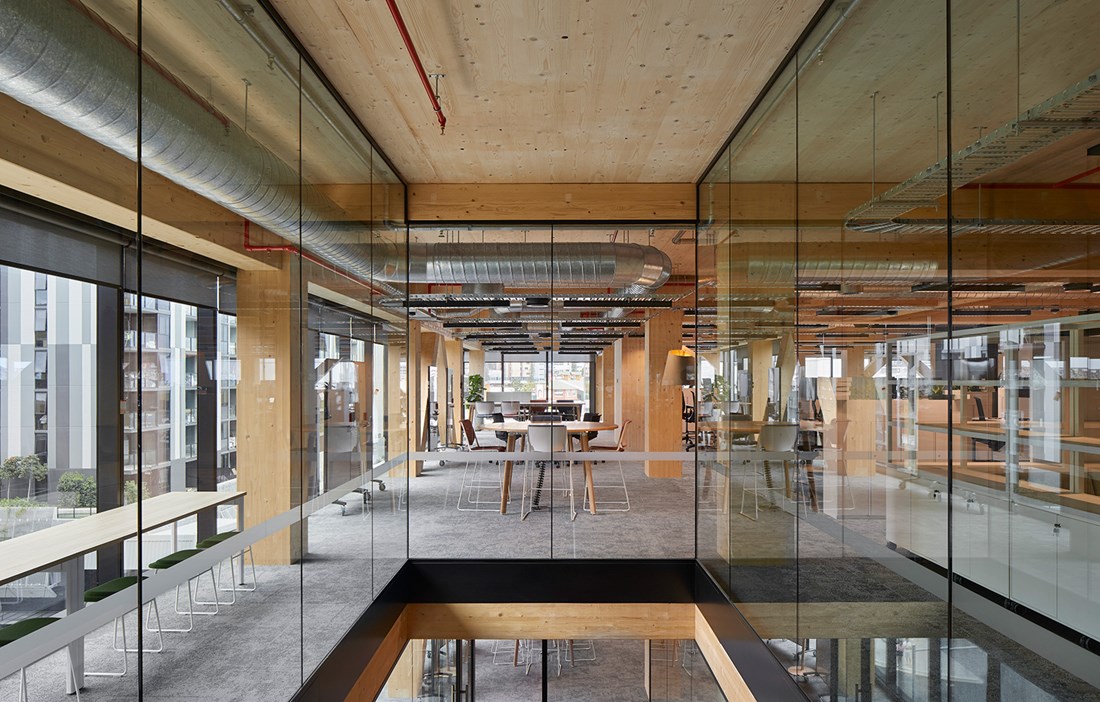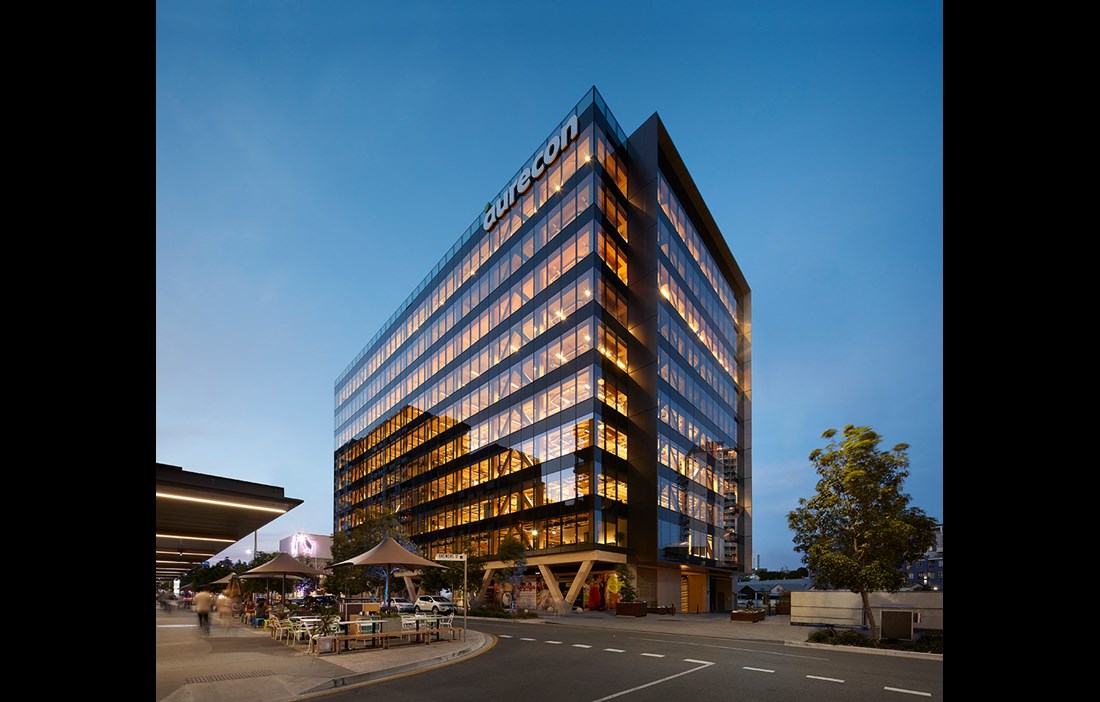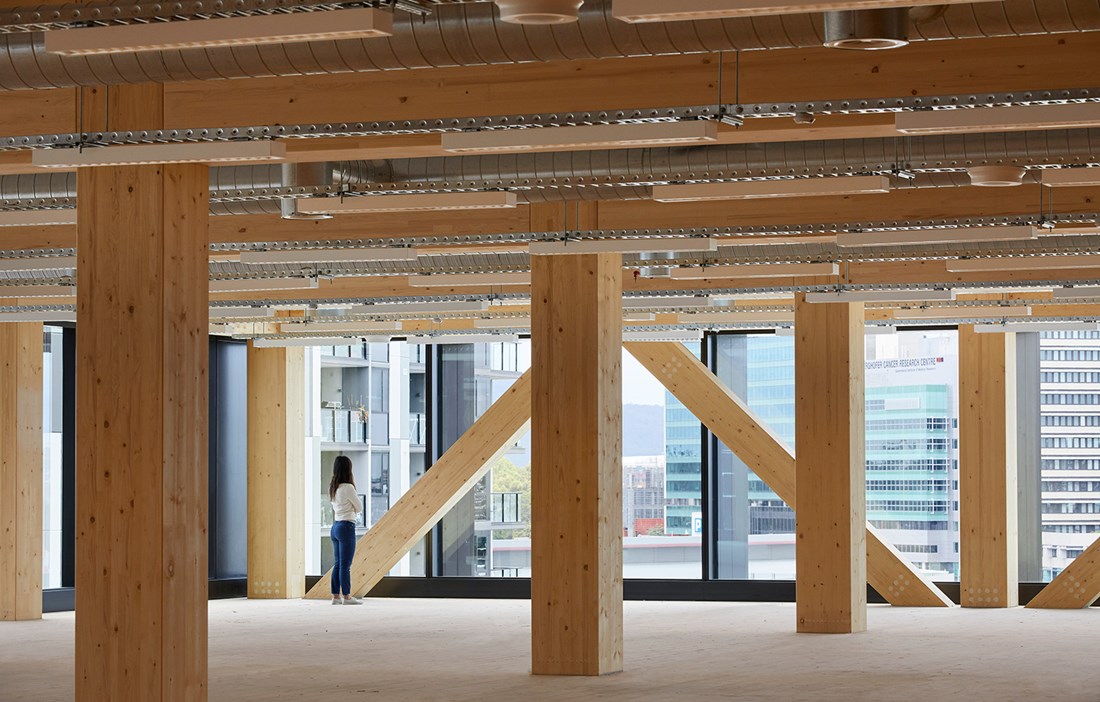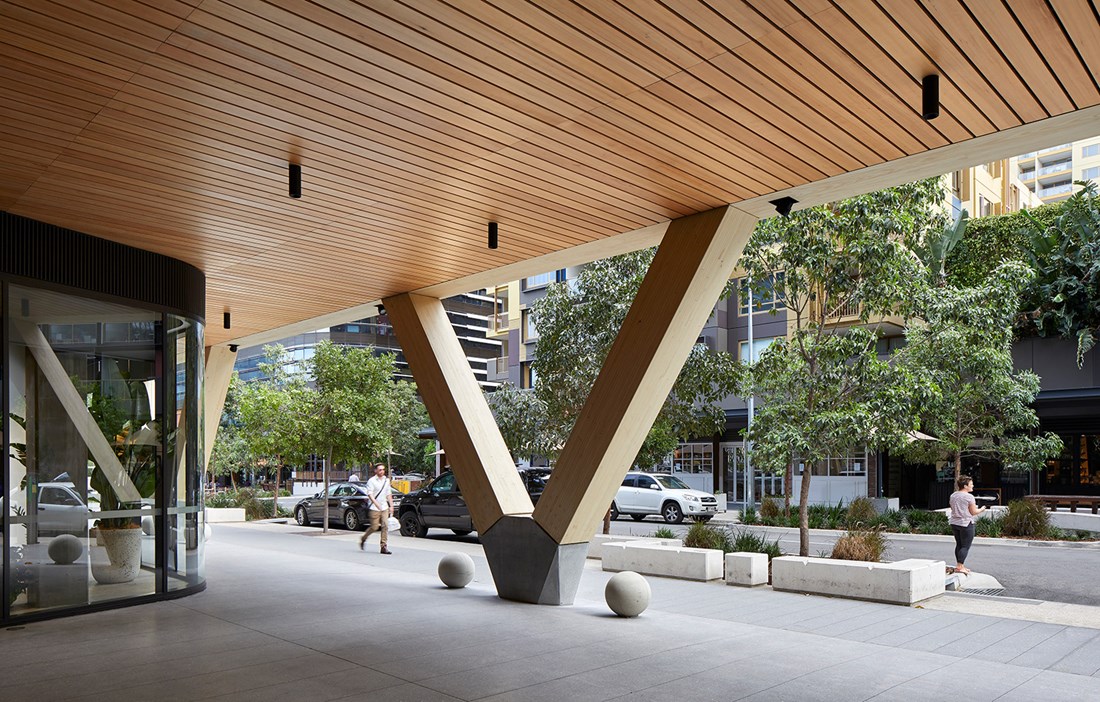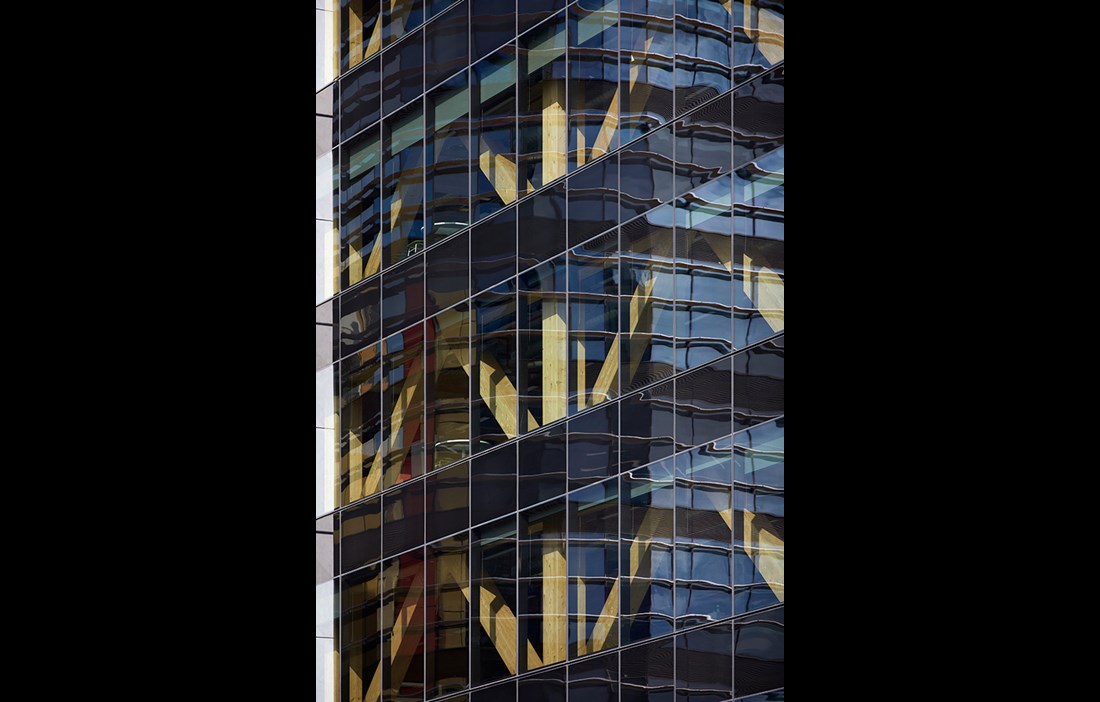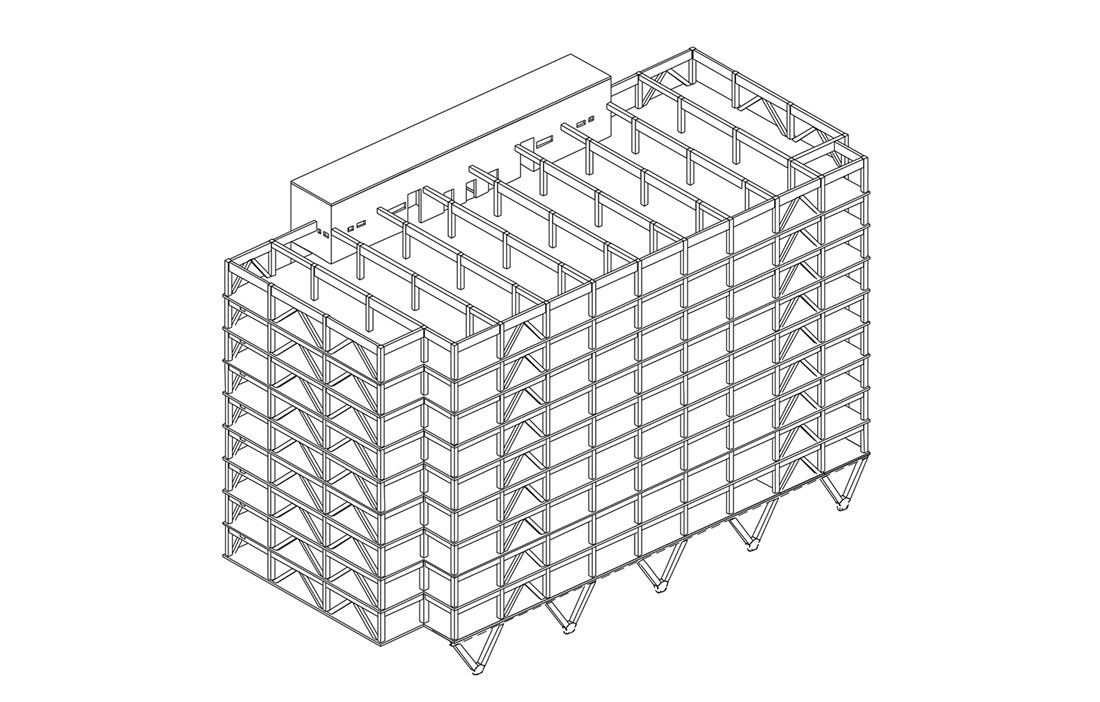Australia has long built family homes with a timber frame, but in recent years several large office blocks in wood have taken shape on the continent on the other side of the world. The latest of these is 25 King, which opened in November last year and is located in Brisbane on the east coast. With its 10 storeys and height of 45 metres, this is not only the tallest wooden building in Australia, but in fact one of the tallest in the world.
“Glulam, CLT and new options for prefabrication using CNC machines have driven up interest in large-scale wood construction in Australia. But we architects still have a lot to learn about the techniques that are used in Europe and Canada,” says Philip Vivian, director and chief architect at Bates Smart Architects, which designed 25 King.
Once again, international construction giant Lendlease is behind this building. Lendlease has several successful wood construction projects under its belt, including Library at the Dock in Melbourne, which won awards for its design and sustainability profile, and International House in Sydney, which Trä! has written about previously (issue 3, 2017).
“We were interested in exploring the opportunities offered by a prefabricated construction system that cuts carbon emissions and delivers warm and pleasant office spaces. I would say that by using wood in 25 King, we’ve been able to improve both comfort and function, while also facilitating a greener and healthier working environment. In addition, choosing wood has put us in a much better position to meet the building’s strict environmental targets,” says Philip Vivian.
The carcase of 25 King is based on a post and beam system using glulam. The walls and floor structure are made from CLT units that were delivered to the site with window and door openings ready cut, along with holes and profiling for the installations. A construction system that uses CLT components is characteristically able to take high loads, handle large spans and absorb major horizontal forces. CLT also provides a suitable and stable surface for fixings and gives the option of having exposed expanses of wood. The advantage of the post and beam system is that it allows for large, open spaces that Lendlease can then adapt to suit its tenants. It is also appropriate when, as in 25 King’s case, the design includes large glazed areas and open façade solutions.
“With 25 King, the whole glazed façade is designed to be self-supporting as a non-load-bearing curtain wall of the kind often used in office buildings. The façade helps to protect the wooden structure and is able to tolerate minor movements,” explains Philip Vivian.
The building is 10 storeys high and provides office space of almost 15,000 square metres. The basement and ground floor are cast in concrete, mainly to resist moisture but also because an attack by the termites that live at these latitudes can cause serious damage to wooden structures. The other storeys make use of over 3,000 individual glulam elements and 21,000 square metres of CLT, which were produced at Stora Enso’s plant in Austria and then shipped in containers to the construction site. Six V-shaped glulam columns on each floor stabilise the building horizontally. Although the use of wood is extensive, it is fascinating to note that on a warm summer’s day it only takes two hours for the Austrian forest to grow back the 6,000 cubic metres or so of wood that it took to build 25 King.
Philip Vivian says that one of the challenges with 25 King has been the need for early documentation to allow for the prefabrication. He believes it requires a whole different approach to establishing the design, coordinating services and resolving the details, before the actual construction can get started.
The floors and ceilings are a combination of 200 millimetre thick CLT panels and a 50 millimetre thick concrete slab. This hybrid system helps to reduce the spread of any fire between the floors, as well as improving the interior acoustics.
The building’s fire safety measures are both passive and active. Passive protection is offered by the wooden frame, which has been sized to maintain its function for two hours in a fire. Active protection takes the form of a sprinkler system that has been installed throughout the building, a concrete slab to reinforce the floors and a safe evacuation route via the stairwell.
“What’s amazing about the fire safety measures in 25 King is that they wouldn’t be considered compulsory in a more typical office block of this size – a building in a material other than wood,” says Philip Vivian.
The open-plan layout is much appreciated by technology consulting firm Aurecon, whose 600 employees have already settled into their new headquarters. In addition to being the anchor tenant in 25 King, Aurecon has worked with Lendlease on the technical installations and other features.
“We’ve opted to leave the installations exposed and not hide the wooden structure behind a suspended ceiling. The result is an exciting contrast between hard and soft, austere and warm, that helps to create a balance,” comments Philip.
Bates Smart Architects has also met Aurecon’s need for separate meeting rooms by creating ‘rooms within a room’. These freestanding boxes are an elegant solution that makes it easy for employees to gain some privacy in the otherwise open-plan office.
Choosing a prefabricated glulam and CLT frame has brought both environmental and financial benefits, not least thanks to the short construction time, which meant that the building could be completed in just 15 months.
“Wood has a positive effect on our wellbeing and delivers good energy efficiency. But the most important factor for us was the climate gains – it takes less energy to manufacture a building made from wood than it does with other types of material, wood stores carbon dioxide for the whole of its life and it’s the only renewable construction material around,” says Philip.
It should not be forgotten, however, that a wooden building is only good for the climate if it stands for a long time, otherwise its capacity to store carbon dioxide becomes less significant. It is therefore important for architects, construction companies and developers to ensure that a wooden building is appreciated and functions as well as intended.
“25 King represents a genuine statement in favour of prefabricated wood construction, and we’re pleased to have learned so much from working on this project. Thanks to 25 King, we architects know much more about CLT, the material’s potential and how we can use it in new and innovative ways,” says Philip Vivian.
25 King is aiming to achieve six stars from Green Star Design and five stars from Nabers Energy, two of the environmental certification schemes used in Australia. The building will also be certified under the Well Building Standard (WELL), which focuses on the wellbeing of the people who use the building.
Following the completion of 25 King in Brisbane, Lendlease has now moved on to its next project, Daramu House in Sydney. This huge office block is set to be finished in 2019 and will complement the entrance to the Barangaroo suburb. Like with its sister building International House Sydney, the CLT elements used will come from Stora Enso’s sawmill in Austria.
The growing popularity of CLT now means, however, that the elements are also available closer to home. March 2018 saw the New Zealand-based company Xlam open the first factory in Australia for the production of structural elements in CLT. The elements are primarily destined for projects such as student accommodation, sheltered housing and public buildings, but the material has also become popular among private individuals.
The new factory is situated between Melbourne and Sydney, a good location for deliveries to the metropolitan areas along the Australian coast, as the CLT can be shipped by sea. The factory is well prepared for the increasing use of CLT. Its capacity of around 60,000 cubic metres per year is significantly greater than the amount consumed in Australia in recent years.
Text Katarina Brandt

